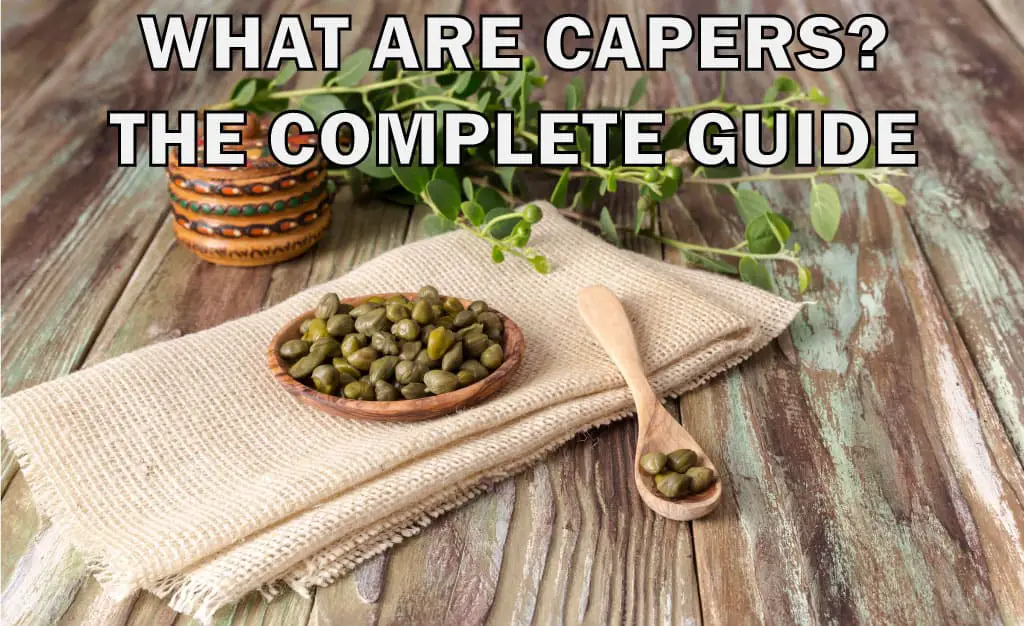So, you’re at a restaurant, you ordered the Chicken Picatta and, as you’re enjoying your delicious, creamy chicken, you bite into something tiny that is just bursting with flavor: a caper. Maybe it’s your first time eating one, or maybe you are an experienced caper consumer who’s just getting more curious, but you may find yourself wondering what on earth that tiny green ball of intense flavor is and where it came from.
Capers are the small, green, round, premature buds of a flower called Capparis Spinosa, or Flinders Rose, plucked before blooming and then pickled or cured for some time. It is not to be confused with the Caper Berry, which is produced post-blooming and is much larger and olive-shaped, as well as more acidic and starchier.
Capers are a complex food with an exciting history and a knock-out flavor profile that chefs and foodies have thoroughly enjoyed. Read on to learn where they came from, what they are used for if they are any good for your health, and even how you can grow and pickle them at home.
Where Capers Come From
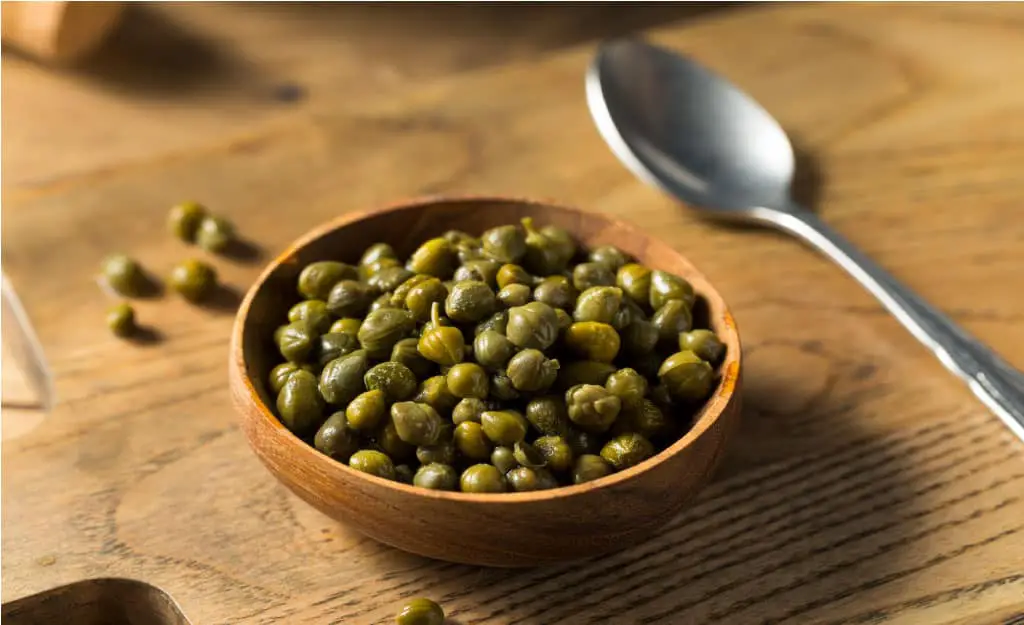
Although they may feel fresh, new, and trendy, the intriguing tiny green spheres of flavor have been around for quite a while. Maybe even for thousands of years. According to thespruceeats.com:
“Its use dates back to 2,000 B.C. where it’s mentioned as a food in the Sumerian Epic of Gilgamesh.”
Despite their ancient origins, it seems that, just like philosophy and college students, each generation of up-and-coming chefs discovers them anew. They then go off on a culinary expedition to use the caper in a new way.
Their experiments can bring life back into an older or more basic dish that, for whatever is lacking, could use their tangy, lemony, salty goodness. It can take an old or repetitive recipe to the next level and bring new light to old flavors. The sky’s the limit here.
But before diving into the modern take on this ancient food, let’s check out where these little buds come from. Their history can add even more to their value.
Historical Origins
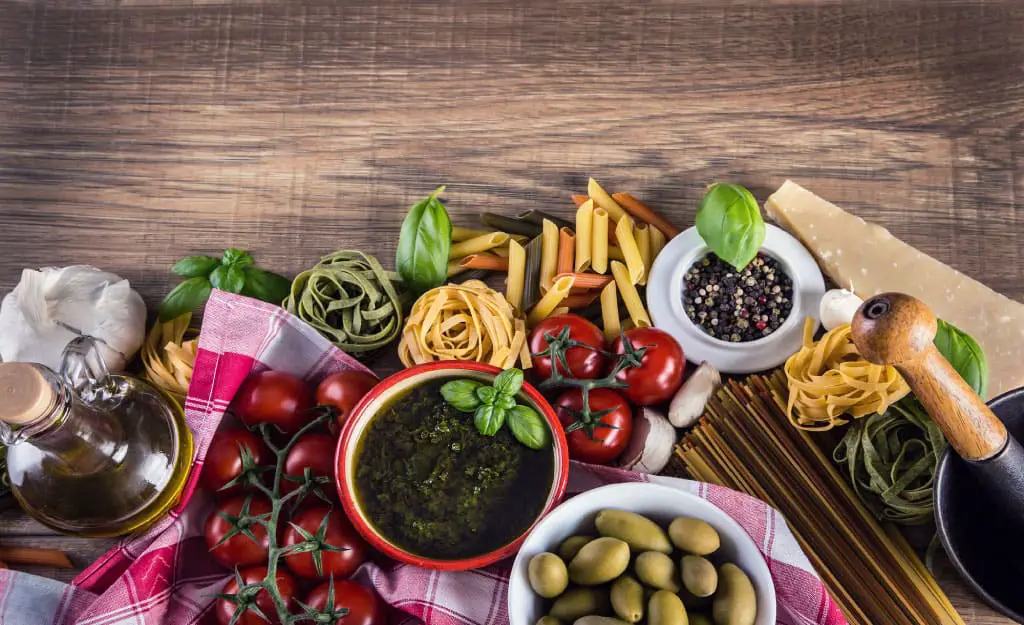
Capers have traditionally been seen in dishes from the Mediterranean and Southern Europe. These are the places that are notable for their caper contributions. Chicken Piccata and Salad Niçoise are possibly some of the most well-known dishes of all time and need no introduction on their own. These places take much of the credit when it comes to making and using capers.
If you dig deeper, though, you will see that capers are not as exclusive as they may have seemed before. They have been found growing wild or farmed small-scale and large scale in many more places. A fairly inclusive list of where capers have been found, grown, sold, or used can include but is not necessarily limited to:
- France
- Italy
- Northern Africa
- India
- The Mediterranean
- Spain
- Southern Russia
- The Middle East
- Asia
- Turkey
And, even more recently, in the U.S.’s west coast state of California. Not as scarce or rare as the price tag on the jar at your local grocery store might suggest if you look more closely.
Each place uses them slightly differently, but they are what they are, and as much as we want them to have variety on their own, the dishes and combinations are really what will differentiate them. Capers taste like capers, no matter where you get them.
Culturally Significant Dishes

Capers are becoming more widely accepted as a commonly used and versatile ingredient throughout the world. Many cultures have their own versions of dishes where capers are either a garnish, a necessary ingredient of the recipe, or maybe even the star of the show.
In Europe, they are known to be found in dishes such as:
- Italian Pasta Puttanesca
- Italian Chicken Piccata
- Italian Antipasto Platters
- Italian Olive/Caper Tapenade
- French Salad Niçoise
In the U.S., they are found garnishing:
- New York Eggs Benedict
- New York Bagel and Lox
And in the Mediterranean, they are commonly found in:
- Baked Fish Dishes
- Sardine Pasta
- Yogurt Sauces and Dips
In Africa, they have them dressing:
- Traditional Fricassee
And in India and the Middle East, you will find them in or garnishing:
- Curried Chicken Dishes
- Grilled Fish Dishes
- Caper-Butters
- Tomato, Celery and Caper salads
- Tahini Caper dressings
- Yellow Lentil Soups
As you may be able to tell, there is no shortage of dishes across the world that utilize capers as an integral part of a recipe or a star garnish. These dishes and dressings are either historical or modern, and sometimes a twist of both or somewhere in between.
Nor will you find that any of these dishes are particularly like one another. They are as different as their cultures, yet capers can complement all the different flavors, spices, and ingredients common for those countries. Capers are a versatile yet unexpected ingredient.
Sources: Huffpost.com tasteatlas.com, gardeningknowhow.com, Loveandlemons.com
Modern Day Growing and Shipping
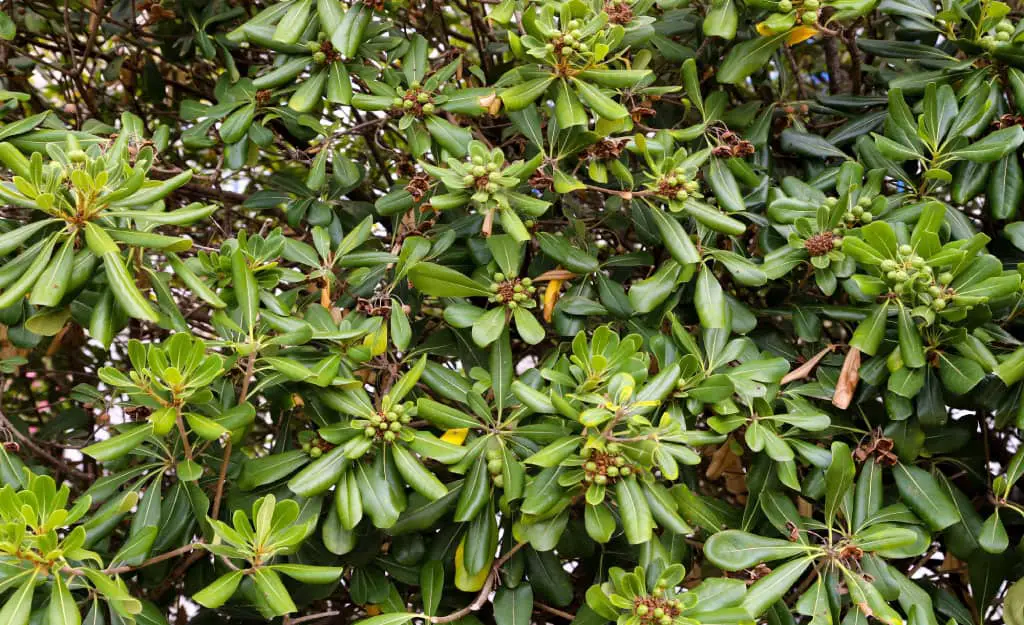
Since capers can be found growing wildly or in small-scale farming worldwide, it could be interesting to discover where the capers came from that are pickled in the jar in your refrigerator. The same ones that were purchased from your local grocery store or market for a price nearing $5 per 4-ounce jar, more or less.
Capers are no cheap condiment, that much is for sure, but what makes them so expensive?
Being imported, exported, and re-exported from importing from countries all over the world, including the U.S., they are not a scarce item. One of the reasons that capers can seem so expensive is how they are grown and collected before the pickling or brining process.
Before a caper seed can even be planted, it needs to be soaked in water overnight. It then remains enveloped in a damp towel in refrigerated temperatures for a minimum of three to five months! Talk about a test of patience. After they are finally planted, the first four months of their growth is a delicate process of constant watering and plenty of direct and warm sun. High maintenance?
Then, once they have been planted and had significant time to grow to their optimal size for collection, the flower’s small buds must be plucked by hand. Their size makes it almost impossible to have any machinery or automation take over the exhausting and time-consuming process of plucking each tiny bud from its stem before the flower can reach the stage of blooming. So, it is done one caper at a time, every day.
This is part of why they are not as cheap as one might assume for their tiny size. Another reason is that the pickling process is also time-consuming, sometimes taking days or weeks to be ready for consumption. Luckily, because of how intense their flavor is, they are recommended to be used in moderation, as a small garnish or an ingredient in a dressing or dip, making the 4-oz jar last you a few weeks, even.
So, while they may not seem that rare, and there may not be a crazy demand for them, the delicate, time consuming, and high maintenance process of getting the caper from seed to bud, and then from bud to caper, is long and arduous.
Source: Gardenerspath.com, Latimes.com
How Capers are Made
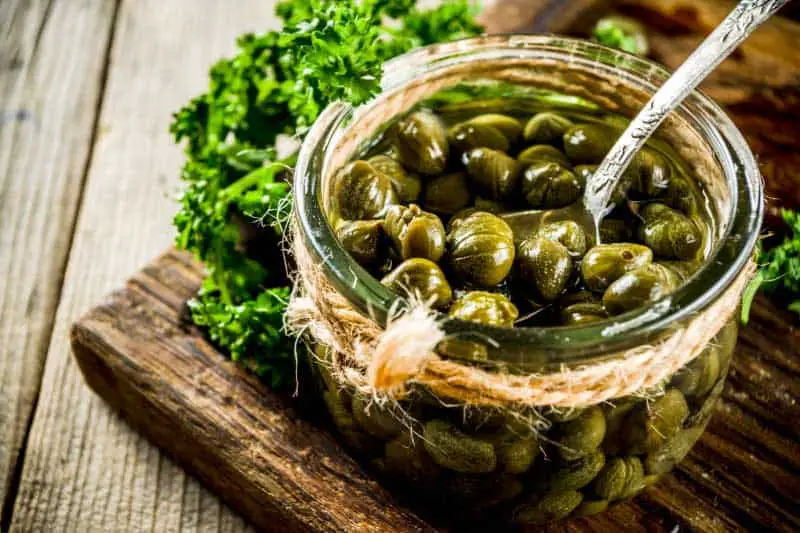
Capers are very similar to olives in the sense that, while delicious and savory once pickled, they are overtly bitter and undesirable when freshly picked. They are never consumed raw and for good reason.
Capers are typically prepared in one of three specific ways:
- Pickled
- Brined
- Dried
As each bud develops at different times, the tiny green spheres must be watched and picked daily, rather than once or twice in a season. It is a constant process of watching and picking the buds that are at the right size and in the right stage of growth to become a delicious caper.
Caper Sizing
Once the capers are picked, they are typically sorted by size. As you can imagine, the size difference is a matter of millimeters, since they are all so small, to begin with.
This process is important, though, because although the size difference is not very noticeable to the eye, the tongue can tell a small, delicate, rich caper from a larger, more acidic, and tough caper.
The sizes are distinguished by names beginning at the smallest and continuing to the larger ones. These names include, in order of smallest to largest:
- Nonpareil
- Surfines
- Capucines
- Capotes
- Fines
The most valuable capers are the nonpareils because they are the smallest. These are known to have a much more delicate texture and pungently perfect flavor. These are often served as a garnish, whole and fresh from the jar, to show off their small size and allow the consumer to savor the texture more than if they were pureed or chopped.
The surfines are the most commonly found, used, and referenced in recipes. These are the ones that you can find at the grocery store in a 4-5oz jar over by the pickles and olives. They are the ones you think of when you hear someone describe a caper and are served in a variety of ways.
While still capable of delivering the flavor punch of the nonpareils and surfines, the larger capers tend to be slightly starchier, more acidic, and tougher, missing that delicate texture that is sought after by chefs and foodies alike. These are often included in dressings, spreads, and other purees rather than served whole as a garnish or in a salad.
Making Capers
Once they are sorted, then begins the pickling, brining, or drying process. Pickling requires vinegar, salt, and spices to be added to a jar along with the capers, and then, over time, the capers will soften and absorb the flavors. The brining process is equally time-consuming, as is the drying process.
Capers are most often found pickled, though. Some various spices or herbs can be included in the process, but the caper requires a particular flavor profile, and, as such, the process can look very similar in most instances.
If you find yourself interested in exploring the world of caper pickling, even just for you and your family to enjoy, you can follow the detailed instructions at thespruceeats.com. They offer two different methods for taking capers from fresh to foodie heaven.
Otherwise, you can try capers in their varied forms and see which kind you prefer.
Capers vs. Caperberries
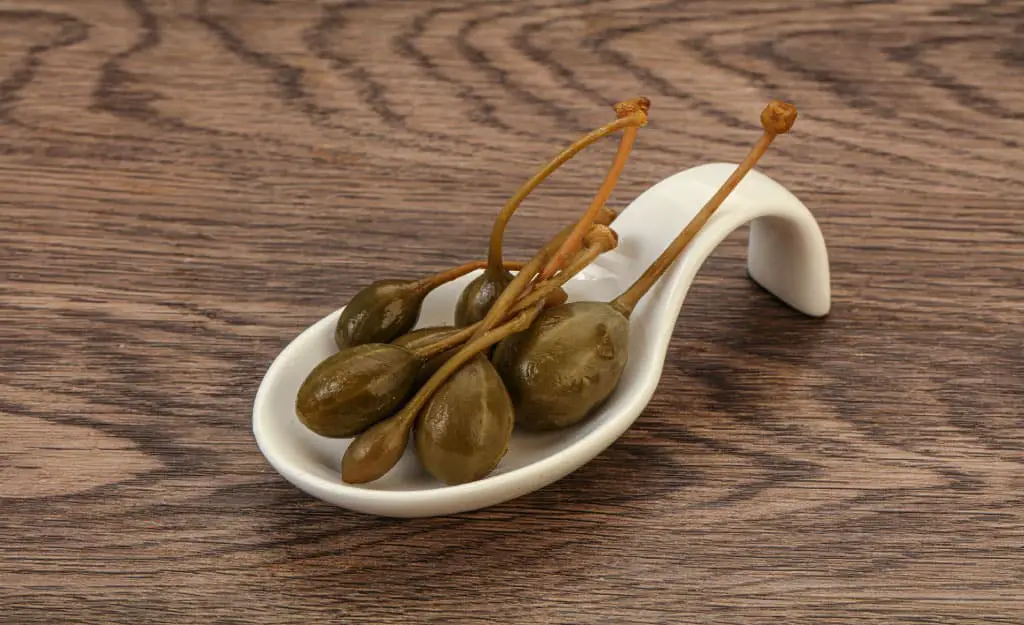
If capers aren’t mysterious enough, add in a twist to keep you guessing: enter the caperberry.
Capers and caperberries are not the same, in case you were wondering. While a caper comes from the undeveloped bud of the Capparis Spinosa flower, the caper berries are the fruit that is produced after the flower has developed and completed its blooming process.
Caperberries are the same green color as capers but, rather than a small pea-sized sphere, they take on a larger, more oblong shape, almost like that of an olive. They also have a signature stem that has been compared to the stem of a cherry.
If that weren’t enough differences, they also have hundreds of seeds in them once cut open (similar to kiwi fruit), absent in the caper bud. They are considerably starchier, and the texture is more unpleasant than the caper bud, especially the smaller ones.
They are almost always pickled, though, in the same way that capers are and can be used in a few of the same dishes as capers, as a replacement or a substitute for their smaller counterpart. They have a similar flavor profile, if not quite the same.
They are more often found on antipasto platters with the olives, served with nuts and cheeses on a charcuterie board, or used as a garnish in a Bloody Mary Cocktail or a Martini, much the same way that a green olive is used in those drinks. They are not recommended to be served as a garnish or in sauces the same way that capers are due to their size and texture differences.
Tips for Cooking with Capers or Caper Berries
If you intend to cook with capers, there are a few things to know to be sure that they will enhance your dish rather than overpower it. The use of capers has to balance the other foods and flavors in a dish. Otherwise, the combinations could turn bitter, or it could end up an over-salted disaster. Because of how distinct they are, a caper does not pair well with some other extreme flavors, so be mindful when cooking with them.
If you wonder where capers get their pungent, tangy, lemon-like saltiness from, you can blame the mustard oil contained within them, which is released when they are smashed. It brings in a bright, acidic bomb of intensity that can bring a dish full circle for perfection when mingled with the vinegar and salt of the pickling process.
If you find that your dish is lacking that tangy, salty flavor but you are short on capers and don’t have time or means to get to some, they have been substituted for:
- Green Olives
- Thyme
- Artichoke Hearts
- Black Olives (less common)
These foods can offer a similar salty, acidic taste, although you may not get as much bang for your buck with these substitutes than with the actual caper, nor will the texture be quite the same.
In a culinary masterpiece, capers can be used whole, chopped finely, or pureed in a tapenade. You can add them to a dish after it is fully cooked and present them as a garnish on the top. You can also stir them into a sauce at the very end of its cooking process to warm them up but keep the shape intact for maximum impact and enjoyment.
Many chefs recommend using them sparingly because of their intensity. Their salt content makes them a risk because once a dish has been overly salted, there is little a chef can do to right that wrong. Too many capers can take the sodium content of a meal through the roof, so garnish lightly; you can always add a few more later if needed.
In some kitchens, it is recommended that they be rinsed before adding them to a dish. This can remove some of the pungent pickling flavors and dampen the saltiness as well, leaving them with their most true-to-form caper flavors, distraction-free.
Either way, when you are looking for your next culinary adventure, keep an eye out for a dish with some capers in it, or perhaps add them to an unexpected dish and see how it goes. We live and we learn, right?
Can You Grow Your Own Capers?
If you have been adding capers to half of your culinary explorations and find yourself wishing that you could just grow and make your own, rather than having to pay for a jar at the grocery store that might be more than it should, make room in your garden. Here’s how to grow capers from seeds or propagate from an existing bush:
Growing from Seeds
As mentioned above, Capparis Spinosa seeds take a little bit of planning to plant. They must be soaked in hot water and refrigerated for about four months before planting. Once they are ready, they should be planted in loose or rocky soil in a sunny, warm environment.
During the first four months of their growth, they are very delicate and high maintenance. They need a lot of water but, once they have survived two full years of growth, then comes the benefits.
After two years post-planting, the Capparis Spinosa bushes become hardy and tolerant plants. They can be left alone most of the time, only requiring watering a few times in the summer or season. They essentially become resistant to drought.
They need constant direct sunlight, preferably outdoors, and can withstand very high temperatures. However, they don’t fare so well with lower to freezing temperatures and should be brought indoors for harsher winter months.
Propagation
If you have access to the caper plants, then propagation could be a great option, especially if you are on a time constraint and don’t have four months to soak the seed before the growing season.
Capparis Spinosa can be propagated by trimming caper berry cuttings in the Spring months and then planting in the same type of soil as the seedlings prefer. The soil should be loose and drain easily. Some even recommend having a heat source of some sort beneath the growing plant.
If you find that your propagated cuttings are not rooting well, then the base of the cuttings can be dipped in a rooting hormone to aid in that process.
What to Expect
Lucky for the gardener, once the caper plant is rooted and has survived its first few months, it becomes low maintenance, hardy, and rewarding to grow. A typical plant can grow to a height of around 2 feet and a diameter of around 10 feet if well taken care of.
They can produce large amounts of capers that must be hand-picked daily and pickled, brined, or dried for consumption. If the caper buds are allowed to remain, then a beautiful white flower will bloom and produce long purple needles and, eventually, a caperberry.
They are not subject to very many diseases, nor do they tend to have any pest problems. The combination of those things, added to the plant’s hardiness, makes it much less of a risk for growing in your yard.
One additional benefit that can be mentioned is that they are great for small-scale farmers because they can be grown in smaller amounts. Farmers don’t need acres of land to begin growing capers commercially; they can be grown on a small patch of land if needed.
The Nutritional Benefits of Capers
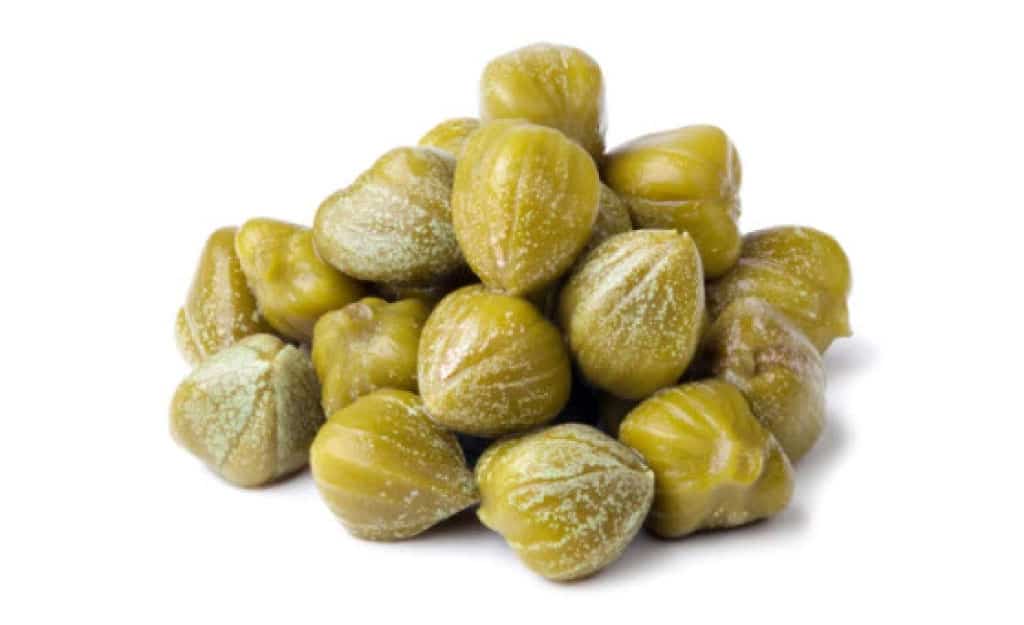
As the saying goes, capers aren’t just a pretty face; or, in this case, a delicious garnish. They also have some substance in those tiny spheres of flavor. Perhaps not enough to add any numbers to your macro count, but they sure are complex in their nutritional content.
Nutritional Content
The serving size for capers, according to webmd.com, is about a tablespoon. And in that tablespoon serving, you are looking at less than 1 gram of:
- Protein
- Fiber
- Carbohydrates
- Sugar
- Fat
So, they won’t be adding any significance to your calorie or macro count for the day, but with those small numbers, they bring more to the table. An article from Myrecipes.com explains that capers are very low in cholesterol but are a great source of:
- Vitamin A
- Niacin
- Iron
- Calcium
- Vitamin C
- Magnesium
- Vitamin E
- Vitamin K
- Folate
As well as a decent source of antioxidants which, (according to Stylecraze.com) in combination with all the other benefits, can not only be great for your overall health but also your skin and hair as well. Just add it to the list of reasons to love capers.
Medicinal Uses
If that list wasn’t impressive enough, certain parts of the caper plant can be used for medicinal purposes as well and have been used in folk medicine for decades, if not longer.
They have been known for their anti-inflammatory abilities. They have been discovered to help eliminate harmful byproducts of processed meats when eaten together that may even protect against illnesses such as certain cancers, as claimed by webmd.com.
That same article also brings to our attention that capers may be able to contribute to reducing the risk of Cardiac Arrhythmia, as well as lend support to Alzheimer’s prevention.
Some scientists believe that they can aid in the relief of:
- Rheumatism
- Diabetes
- Chest congestion
- Flatulence
The only risk that capers pose comes with their unavoidably high sodium content. If you are required to be on a low-sodium diet or are trying to watch your sodium intake per the recommendation of a health professional or for personal reasons, then be sure to keep your caper intake low enough to maintain those guidelines or goals.
Food for Thought
While capers are a powerhouse for their flavor profiles and small size, they should be enjoyed in moderation due to the sodium content. They can add dimension, texture, and savory goodness to an otherwise bland dish or complement an array of equally complex flavors to make a dish excel and make that entrée extra exciting.
They may be slightly tricky to plant initially, but as time goes on, they become hardy and tolerant plants that produce daily buds for picking and pickling. They come from all over the world and are not to be limited in their creative culinary expansion.
Sources: Thespruceeats.com, thespruceeats.com2, bonapetite.com, eatthis.com, loveandlemons.com, tasteofhome.com, myrecipes.com, huffpost.com, webmd.com, stylecraze.com, gardeningknowhow.com, latimes.com, eatthis.com, gardenerspath.com, tasteatlas.com, webmd.com2.

